A Multiscale Approach to Identifying Vernacular Landscape Pattern Characteristics in River Basins: A Case Study of the Liuxi River, Guangzhou
Abstract
1. Introduction
2. Materials and Methods
2.1. Study Area
2.2. Data Sources
2.3. Research Methodology
2.3.1. Step 1: Scale Definition
2.3.2. Step 2: Pattern Identification
- Historical Background Evolution Analysis: Focusing on the “natural–agricultural–settlement” landscape systems, textual information is integrated to outline long-term historical evolution stages and characteristics. Some information can be visualized using the ArcGIS platform.
- Type Definition and Partitioning: At the basin scale, pattern type classification follows the process of “overlay and pattern recognition—landscape unit division—landscape unit classification”, with boundaries defined by the types of units. At the unit scale, landscape types are classified based on factors such as historical origins and natural geography, with boundaries delineated by the patch boundaries of vernacular landscape elements.
2.3.3. Step 3: Feature Description
- Landscape Pattern Feature Description: Landscape pattern indices can be used to quantify the spatial pattern (composition and configuration) of land cover features [34]. Each index carries unique ecological significance. The study used FRAGSTATS software (4.2) [35] to analyze changes in five landscape characteristics: area and edge, aggregation, shape, fragmentation, and diversity. At the basin scale, six metrics were selected, while at the vernacular unit scale, nine metrics were selected (Table 2).
- Extraction of Core Pattern Characteristics: Combining desk-based research and field survey results, the core characteristics of various landscape types are described from four aspects: natural landscape, agricultural landscape, settlement landscape, and overall landscape pattern.
2.3.4. Step 4: Factor Analysis
3. Results
3.1. Definition of the “Basin–Vernacular Unit” Research Scale
3.2. Basin Scale Vernacular Landscape Pattern Characteristics
3.2.1. Historical Evolution of Vernacular Landscape
3.2.2. Identification of the Characteristics of Vernacular Landscape Patterns
3.2.3. Description of the Characteristics of the Patterns of Vernacular Landscape
3.2.4. Factors Influencing Vernacular Unit Patterns Differentiation
3.3. Unit Scale Vernacular Landscape Pattern Characteristics
3.3.1. Historical Evolution of Vernacular Landscape in the Shaxi River Unit
3.3.2. Identification of the Characteristics of Vernacular Landscape Patterns of the Shaxi River Unit
3.3.3. Description of the Characteristics of Vernacular Landscape Patterns in the Shaxi River Unit
3.3.4. Factors Influencing the Evolution of Vernacular Unit Patterns in the Shaxi River Unit
- Agricultural Land Transformation: The agricultural landscape in the unit shifted from food crops to cash crops, such as nurseries and orchards, leading to increased fragmentation and diversity in cropland landscapes, thus creating a multifunctional agricultural landscape.
- Urbanization and Population Mobility: Industrial development during the urbanization process led to the migration of rural populations. As a result, agricultural land was left uncultivated, and these abandoned fields became irregularly scattered within the orchard and vegetable field landscapes.
- Diminishing Vernacular Social Relationships: The lack of strong vernacular social relationships has led to the irregular distribution of newly constructed settlements. Villages established before the Ming and Qing dynasties followed a comb-like layout. However, newer settlements established after the 19th century tend to be located along major transportation corridors. Village residents construct houses on existing orchards or rice fields, resulting in settlements being distributed in a fragmented and scattered pattern.
4. Discussion
4.1. Methods for Character Recognition of Vernacular Landscape Patterns
4.2. Landscape Management Recommendations
4.3. Limitations and Future Research
5. Conclusions
- The Liuxi River basin experienced three main phases of development, resulting in three predominant settlement patterns: even distribution along the riverbanks, clustering in river valleys, and dispersion in hilly and mountainous areas;
- In 1985, the landscape patterns of the Liuxi River basin exhibited distinct characteristics in terms of landscape fragmentation, dominance, and diversity between the upper and lower reaches. The analysis classified the units into 12 landscape types based on the heterogeneity of natural features, cropland, and settlements;
- From the pre-Qin period to the present, the vernacular landscape evolution of the Shaxi River unit can be categorized into three stages, resulting in two main traditional settlement patterns: “forest-village-pond-field-river” and “forest-river-village-pond-field”;
- From 1974 to 2020, the landscape patterns of the Shaxi River unit tended toward fragmenting into irregular shapes and increased diversity.
Author Contributions
Funding
Data Availability Statement
Conflicts of Interest
References
- Altaba, P.; García-Esparza, J.A.; Valentín, A. Assembling Cultural and Natural Values in Vernacular Landscapes: An Experimental Analysis. Remote Sens. 2022, 14, 4155. [Google Scholar] [CrossRef]
- Siddique, M.A.; Wang, Y.; Xu, N.H.; Ullah, N.; Zeng, P. The Spatiotemporal Implications of Urbanization for Urban Heat Islands in Beijing: A Predictive Approach Based on CA-Markov Modeling (2004–2050). Remote Sens. 2021, 13, 4697. [Google Scholar] [CrossRef]
- Liu, X.; He, J.T.; Xiong, K.; Liu, S.; He, B.J. Identification of factors affecting public willingness to pay for heat mitigation and adaptation: Evidence from Guangzhou, China. Urban Climate 2023, 48, 19. [Google Scholar] [CrossRef]
- Liu, B.; Chen, P. Evaluation and optimization of rural landscape features based on the science of human settlements. J. Chin. Urban 2020, 18, 1–8. [Google Scholar]
- Wang, X. RETRACTED: The practice teaching of regional cultural expression in rural landscape planning and design under the background of urban–rural integration. Int. J. Electr. Eng. Educ. 2023, 60, 3625–3641. [Google Scholar] [CrossRef]
- The State Council of the People’s Republic of China. Opinions of the CPC Central Committee and the State Council on the Implementation of the Rural Revitalization Strategy. Available online: https://www.gov.cn/gongbao/content/2018/content_5266232.htm (accessed on 1 April 2025).
- The State Council of the People’s Republic of China. Instructions on Comprehensively Promoting Rural Revitalization and Accelerating Agricultural and Rural Modernization. Available online: http://www.gov.cn/zhengce/2021-02/21/content_5588098.htm (accessed on 1 April 2025).
- The State Council of the People’s Republic of China. Opinions of the Central Committee of the Communist Party of China and the State Council on Learning from and Applying the Experiences of the ‘Thousand Villages Demonstration, Ten Thousand Villages Renovation’ Project to Effectively Promote Comprehensive Rural Revitalization. Available online: https://www.gov.cn/zhengce/202402/content_6929934.htm (accessed on 1 April 2025).
- Xu, H.; Zhang, T.; Ge, B.; Song, Y. Developing of rural settlement landscape gene research system based on content analysis. J. Asian Archit. Build. Eng. 2023, 22, 2839–2850. [Google Scholar] [CrossRef]
- Li, Y.; Zhou, Y.; Cai, R.; Wang, C.; Wu, X. Chinese Rural Landscapes at Multiple Scales: Typologies and Diversity. Int. J. Environ. Res. 2024, 18, 42. [Google Scholar] [CrossRef]
- Jackson, J.B. Discovering the Vernacular Landscape; Yale University Press: New Haven, CT, USA, 1984. [Google Scholar]
- Andaroodi, E.; Sahrakaran, B. Vernacular Cultural Landscape of Qazvin’s Traditional Gardens: A Review of Basic Conepts and Analysis of Elements and Features within the Scope of Built Environment. Bagh-E Nazar 2017, 14, 39–48. [Google Scholar]
- Swanwick, C. Landscape Character Assessment. Guidance for England and Scotland; The Countryside Agency: Cheltenham, UK, 2002.
- Brown, S.; Youbo, Z. Landscape Planning in New Zealand. Chin. Landsc. Archit. 2013, 29, 12–17. [Google Scholar]
- Ziting, B.; Jianyun, Z. The Practice and Experience of Landscape Character Assessment in Hong Kong. Chin. Landsc. Archit. 2015, 31, 100–104. [Google Scholar]
- Clark, J.; Fairclough, G.; Darlington, J. Using Historic Landscape Characterization; English Heritage; Lancashire County Council: Preston, UK, 2004.
- England, H. Historic Landscape Characterisation. Available online: https://historicengland.org.uk/research/methods/characterisation/historic-landscape-characterisation/ (accessed on 1 April 2025).
- Fairclough, G.; Herring, P. Lens, mirror, window: Interactions between Historic Landscape Characterisation and Landscape Character Assessment. Landsc. Res. 2016, 41, 186–198. [Google Scholar] [CrossRef]
- Brown, G.; Brabyn, L. The extrapolation of social landscape values to a national level in New Zealand using landscape character classification. Appl. Geogr. 2012, 35, 84–94. [Google Scholar] [CrossRef]
- Griffiths, G. Transferring landscape character assessment from the UK to the Eastern Mediterranean: Challenges and perspectives. Land 2018, 7, 36. [Google Scholar] [CrossRef]
- Jellema, A.; Stobbelaar, D.-J.; Groot, J.C.; Rossing, W.A. Landscape character assessment using region growing techniques in geographical information systems. J. Environ. Manag. 2009, 90, S161–S174. [Google Scholar] [CrossRef]
- Gkoltsiou, A.; Paraskevopoulou, A. Landscape character assessment, perception surveys of stakeholders and SWOT analysis: A holistic approach to historical public park management. J. Outdoor Recreat. Tour. 2021, 35, 100418. [Google Scholar] [CrossRef]
- Wu, Y.; Wang, H.; Zhang, B. Landscape Character Diversity and Zoning Management: Case of Wuhan Metropolitan Area. J. Urban Plan. Dev. 2021, 147, 04020062. [Google Scholar] [CrossRef]
- Pan, Y.; Wu, Y.; Xu, X.; Zhang, B.; Li, W. Identifying terrestrial landscape character types in China. Land 2022, 11, 1014. [Google Scholar] [CrossRef]
- Wang, Y. From fragments to system: A research on the mesoscale structure of vernacular landscapes in the Hang-Jia-Hu area, China. J. Asian Archit. Build. Eng. 2024, 1–20. [Google Scholar] [CrossRef]
- Li, G. Identification of Landscape Characteristics for Traditional Settlements in the Wuling Mountain Area Base on Integrated Protection. Ph.D. Thesis, Huazhong Agricultural University, Wuhan, China, 2017. [Google Scholar]
- Wang, N.; Lu, Q. Study on Traditional Rural Village’s Protection and Development Based on the Concept of Landscape Gene. South Archit. 2017, 3, 58–63. [Google Scholar]
- Xuan, G.; Yanyu, C. Historic England Area Assessment Methodology. Urban Plan. Int. 2019, 34, 155–158. [Google Scholar]
- Li, X.; Xiao, J.; Wang, J.; Wu, J.; Long, N. Research on the Asset Valuation and Application of Natural Resources assets for Ecological Restoration: A case study of Guangzhou City. Acta Ecol. Sin. 2022, 42, 1192–1202. [Google Scholar]
- The People’s Government of Conghua District, Guangzhou Municipality. Circular on the Issuance of the Outline of the Fourteenth Five-Year Plan for the National Economic and Social Development of Conghua District, Guangzhou City and the Visionary Goals for 2035. Available online: https://www.gz.gov.cn/zt/jjsswgh/qjgh/content/post_7618501.html (accessed on 1 April 2025).
- Yang, J.; Huang, X. The 30 m annual land cover dataset and its dynamics in China from 1990 to 2019. Earth Syst. Sci. Data 2021, 13, 3907–3925. [Google Scholar] [CrossRef]
- Feng, Z. Researching of traditional villages and houses of Guangzhou area basing on the cultural geography. Master’s Thesis, South China University of Technology, Guangzhou, China, 2014. (In Chinese). [Google Scholar]
- Chen, L.; Lu, Y.; Fu, B.; Wei, W. A framework on landscape pattern analysis and scale change by using pattern recognition approach. Acta Ecol. Sin. 2006, 26, 663–670. (In Chinese) [Google Scholar]
- Long, J.; Nelson, T.; Wulder, M. Regionalization of Landscape Pattern Indices Using Multivariate Cluster Analysis. Environ. Manag. 2010, 46, 134–142. [Google Scholar] [CrossRef]
- Davis, J.C.; Sampson, R.J. Statistics and Data Analysis in Geology; Wiley: New York, NY, USA, 1986; Volume 646. [Google Scholar]
- Li, G.; Jiang, C.; Du, J.; Jia, Y.; Bai, J. Spatial differentiation characteristics of internal ecological land structure in rural settlements and its response to natural and socio-economic conditions in the Central Plains, China. Sci. Total Environ. 2020, 709, 135932. [Google Scholar] [CrossRef]
- Guoping, R.; Liming, L.; Yonghu, F.; Chengcheng, Y.; Zhijun, S. Analysis of characteristic and influencing factors of rural settlement landscape pattern in metropolitan suburbs. Trans. Chin. Soc. Agric. Eng. 2016, 32, 220–229. (In Chinese) [Google Scholar]
- Boven, K.; Morohashi, J. Best Practices Using Indigenous Knowledge; Nuffic: The Hague, The Netherlands, 2002. [Google Scholar]
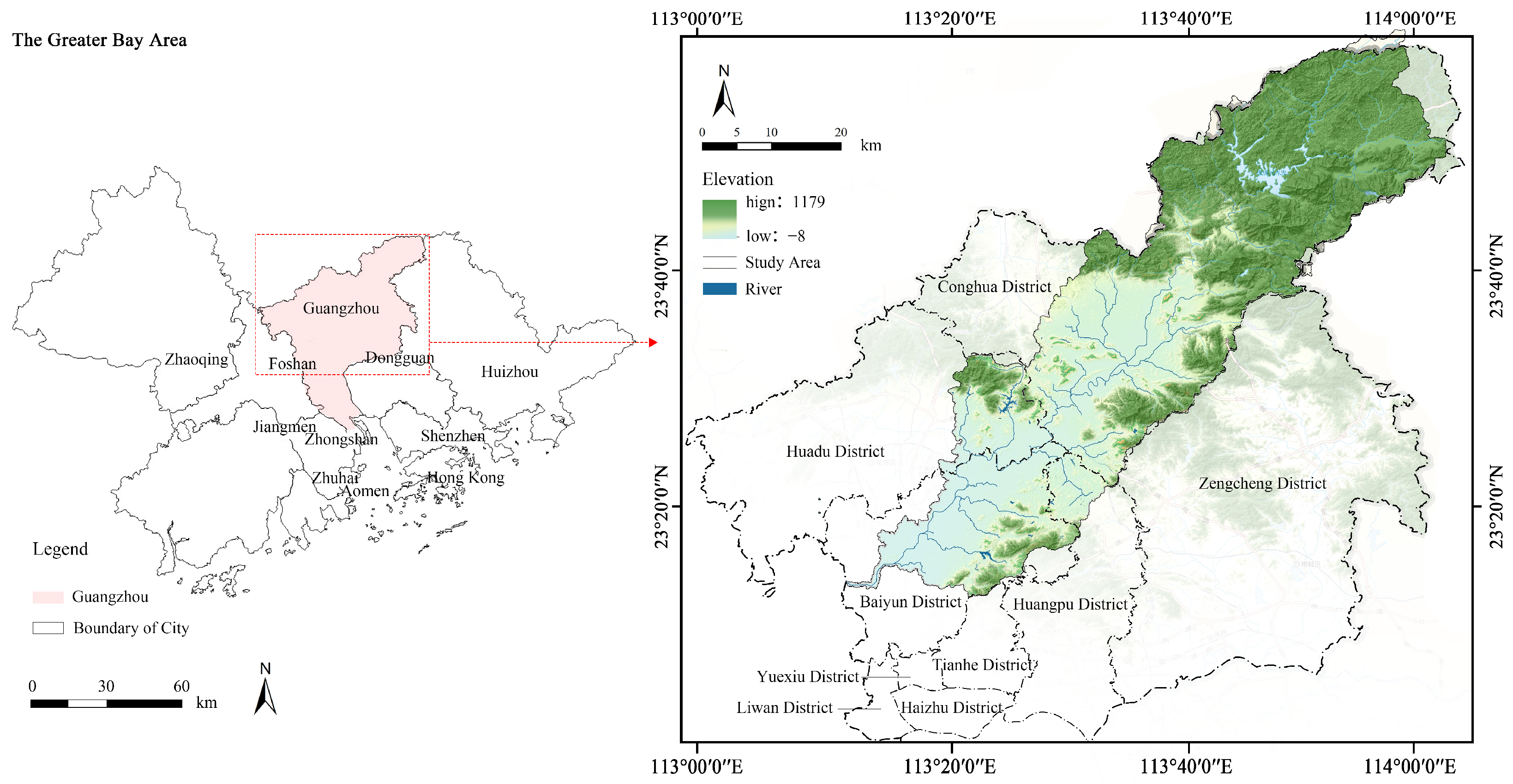

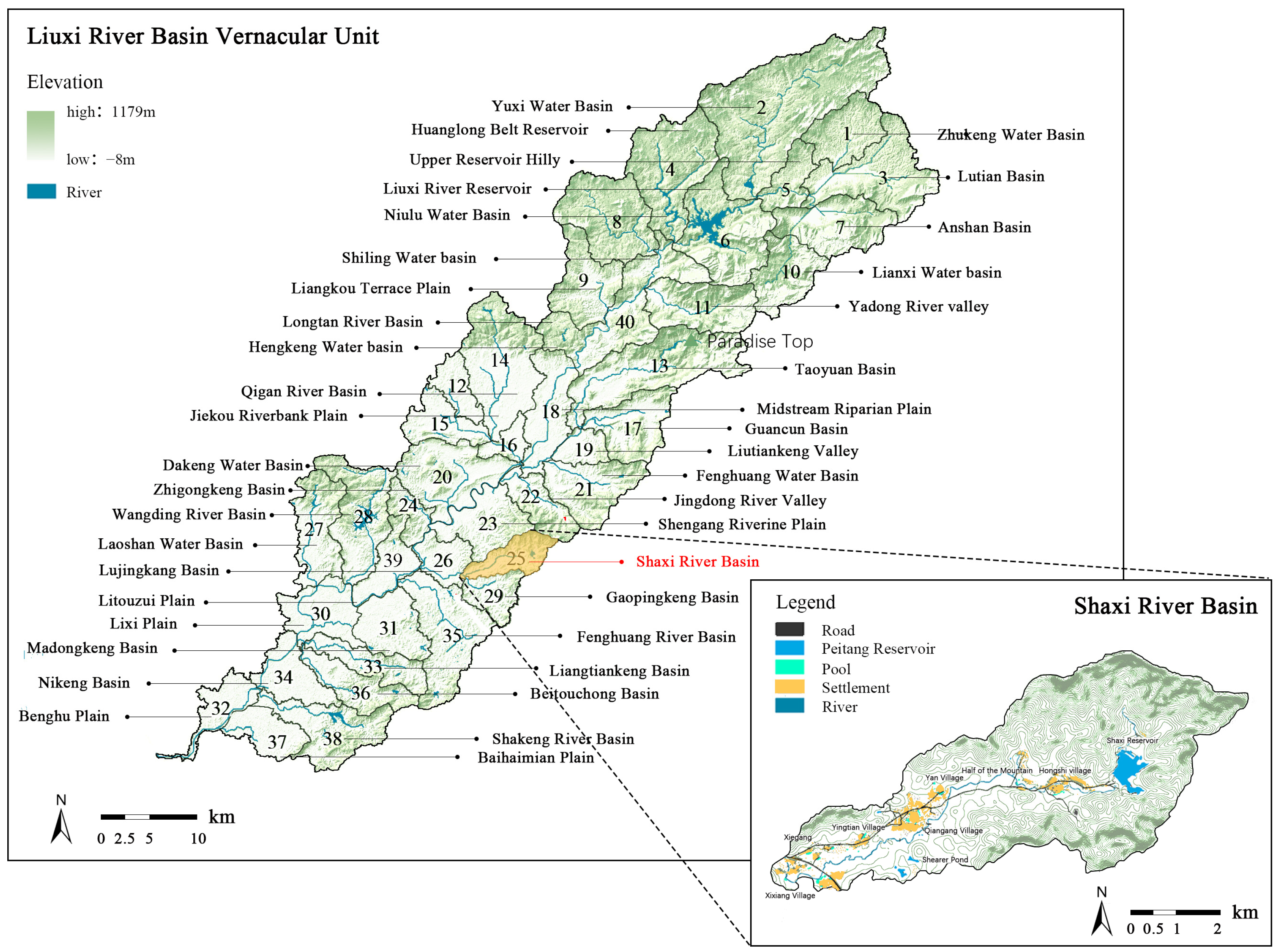
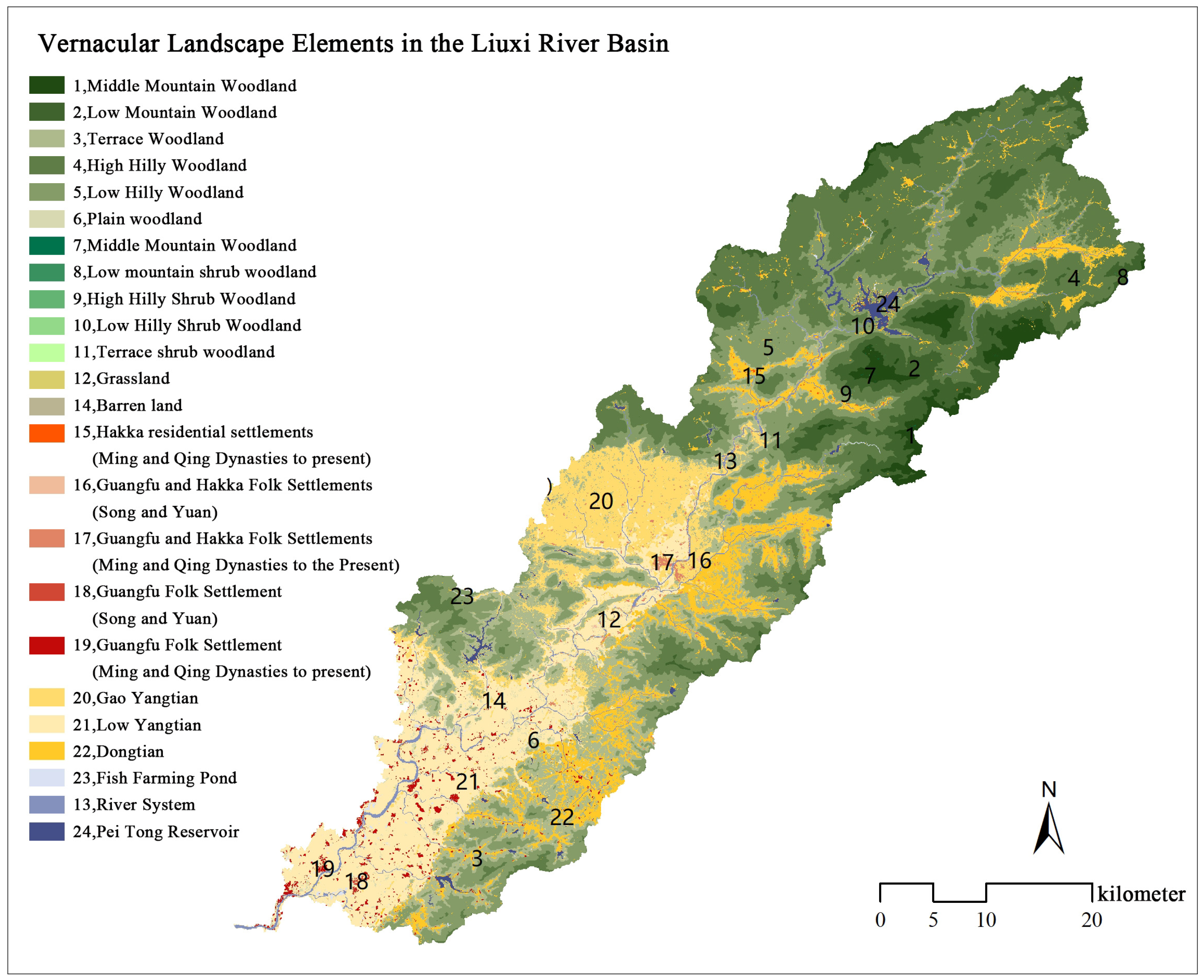
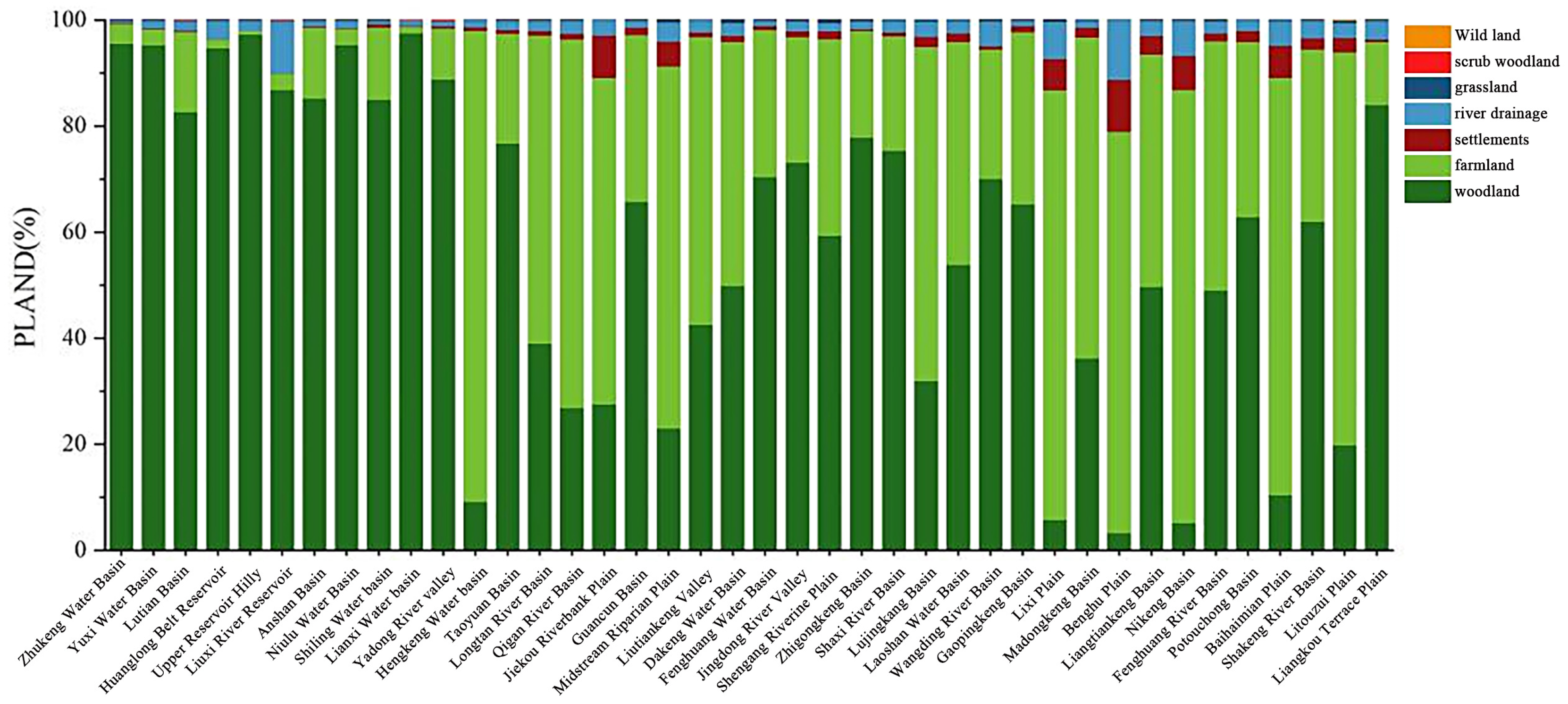

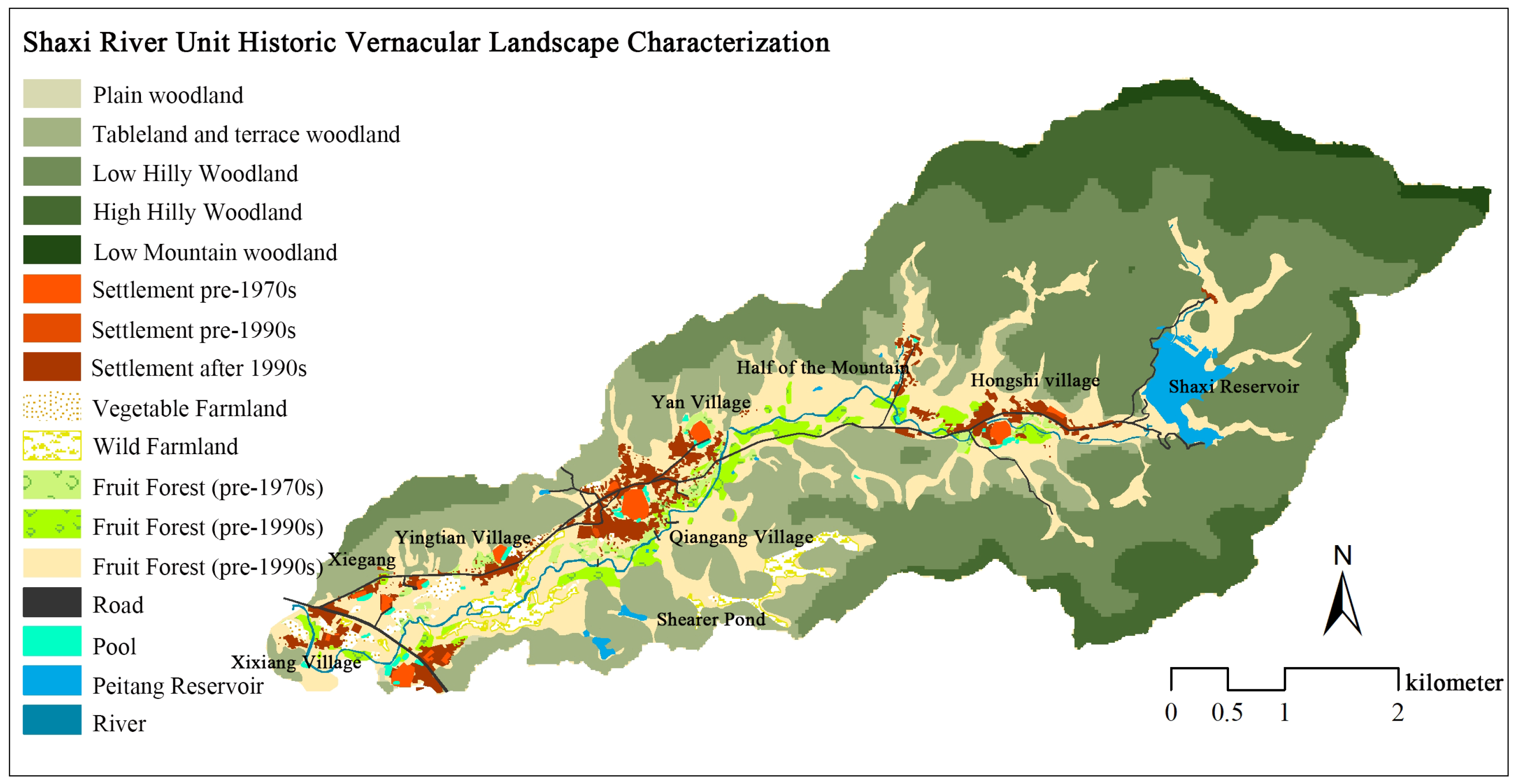
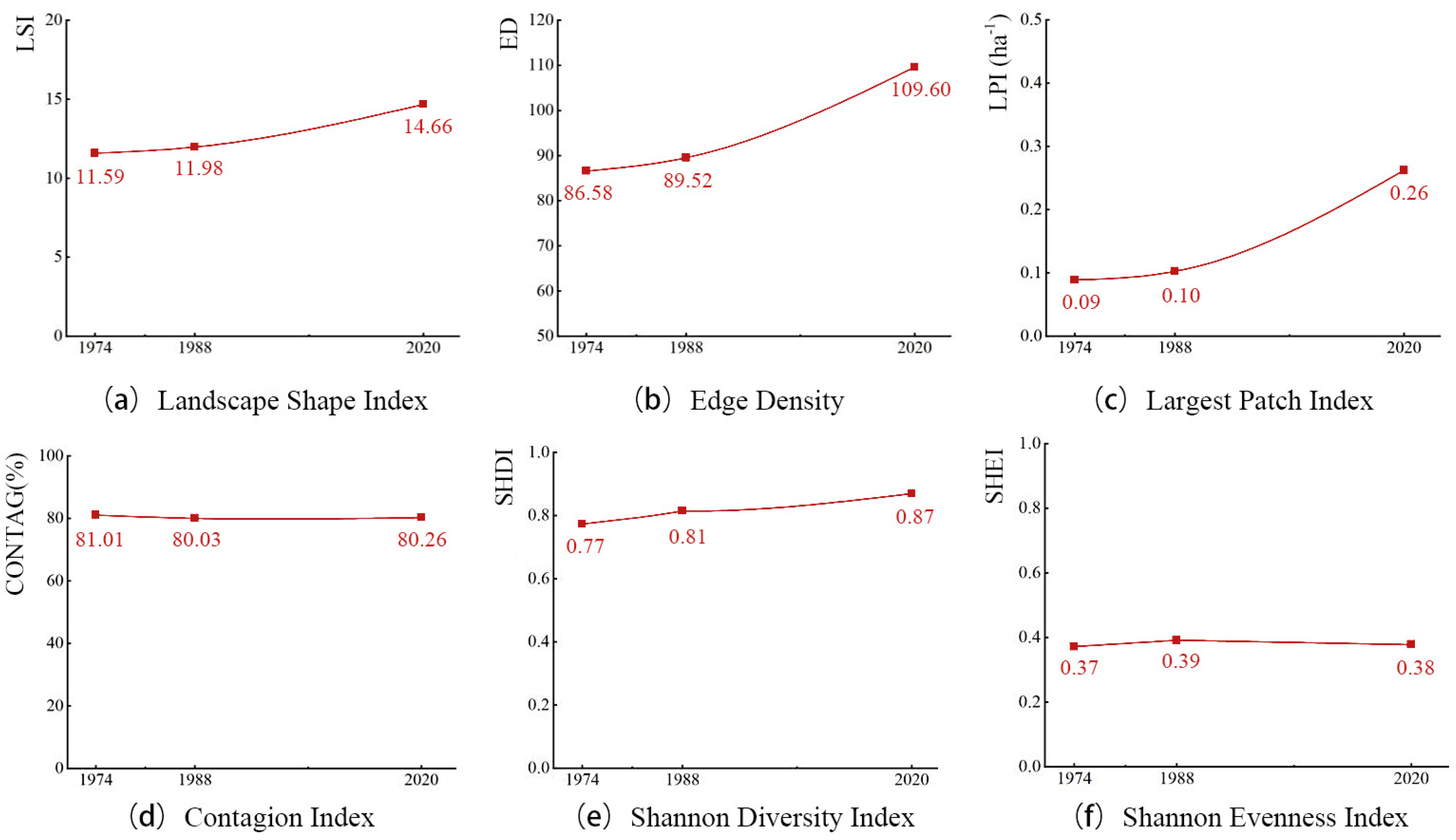
| Data Type | Source Date | Data Name | Source | Specification | Accuracy |
|---|---|---|---|---|---|
| Soil | 1978–1984 | Second National Soil Survey Data | National Earth System Science Data Center, China | .shp | 1:1,000,000 |
| Slope | 2006–2011 | ALOS Satellite DEM Data | European Space Agency | .tiff | 12.5 m |
| Landform | |||||
| River System | 2006–2011 | ALOS Satellite DEM Data | European Space Agency | .tiff | 12.5 m |
| 2018 | “Liuxi River Basin Scope Map” | Guangzhou Water Bureau | .jpg | - | |
| Land Use | 1985 | 1985 Land Cover Data | Yang, 2021 [31] | .tiff | 30 m |
| 1974 | 1974 Keyhole Satellite Imagery | United States Geological Survey | .tiff | 2.3 m | |
| 1988 | 1988 SPOT-1 Satellite Imagery | European Space Agency | .tiff | 20 m | |
| - | Multi-year Google Earth Satellite Images | Google earth | .jpg | - | |
| Placement of Settlements | 2020 | POIs for Settlements | Gaode Map (Chinese website) | .shp | - |
| 1870–1871 | “Illustrated Guangdong” | library | text | - | |
| –2015 | “Villages of Guangdong: A Comprehensive Overview” | ||||
| 1535–1822 | “General Gazetteer of Guangdong” | ||||
| 1730, 1930 | “Chronicle of Conghua County” | ||||
| 2014 | Cultural Zoning of Settlements | Feng, 2014 [32] | .jpg | - |
| Characteristic | Metric | Description | Range |
|---|---|---|---|
| Area and Edge Metrics | Patch Area (CA) 1,2 | CA equals the sum of the areas of all patches of the corresponding patch type. | CA > 0 |
| Percentage of Landscape (PLAND) 1,2 | PLAND equals the percentage the landscape comprised of the corresponding patch type. | 0 < PLAND ≦ 100 | |
| Edge Density (ED) 2 | ED reflects the complexity of patch edges. | ED ≥ 0 | |
| Aggregation Metrics | Mean Nearest Neighbor Distance (MNN_MN) 1 | MNN_MN indicates the mean shortest distance between patches. | MNN_MN ≥ 0 |
| Shape Metrics | Landscape Shape Index (LSI) 2 | LSI reflects the degree to which patch shapes deviate from a rectangular shape. | LSI ≥ 1 |
| Fragmentation Metrics | Mean Patch Area (AREA_MN) 1,2 | AREA_MN reflects the average size of land-use types including settlements and farmland within different vernacular landscape units. | AREA_MN ≥ 0 |
| Largest Patch Index (LPI) 2 | LPI equals the percent of the landscape that the largest patch comprises. | 0 < LPI ≦ 100 | |
| Contagion Index (CONTAG) 1,2 | CONTAG reflects the connectivity and spread of dominant landscape types. | 0 < CONTAG ≦ 100 | |
| Diversity Metrics | Shannon’s Diversity Index (SHDI) 1,2 | SHDI reflects landscape heterogeneity. | SHDI ≥ 0 |
| Shannon’s Evenness Index (SHEI) 2 | SHEI reflects the distribution uniformity among different landscape type patches. | 0 ≦ SHEI ≦ 1 | |
| Patch Richness (PR) 1 | PR equals the number of different patch types present within the landscape boundary. | PR ≥ 1 |
| Influencing Factor | Type of Variable | Description of the Calculation Method | |
|---|---|---|---|
| Topographical Factors | Terrain undulation | Continuous Variables | The terrain undulation reflects the topographic variation characteristics of the region. |
| Elevation | Hierarchical Variables | The elevation was calculated using DEM data. | |
| Slope | Hierarchical Variables | The slope was calculated using DEM data. | |
| Hydrological Factors | Average Distance from Settlements to Water Systems | Continuous Variables | A multi-ring buffer analysis was conducted for hydrological features (e.g., rivers, reservoirs, and ponds) by generating concentric buffer zones at radii of 0.1 km, 0.3 km, 0.5 km, 0.7 km, 1 km, and 3 km along the water systems. The number of settlements within each water system buffer zone is then summarized. |
| Agricultural Factors | Cropland Radius | Hierarchical Variables | The cultivation radius was determined using a buffer analysis method, in which concentric buffers were incrementally expanded outward from settlements until the buffer area equaled the total cultivated land area. The corresponding buffer radius at this threshold was defined as the cultivation radius. |
| Serial No. | Vernacular Unit Type | Vernacular Unit | Natural Landscape System Characterization | Settlement Landscape System Characterization | Agricultural Landscape System Characterization | Vernacular Landscape Pattern | ||||
|---|---|---|---|---|---|---|---|---|---|---|
| Landform Feature | Average Elevation | Concentration of Settlement | Mean Distance From Settlement to Water System | Cultural-ethnic settlement cluster | Agricultural Landscape | Water Conservancy | - | |||
| 1 | River Plain-Field-Guangfu and Hakka Settlement Landscape | 26 | River Plain | 33.7 m | 33.7 m | 260.8 m | Guangfu, Hakka | Low Yangtian 2, High Yangtian 3 | Installation of barrages along the main stem of the Liuxi River and the use of irrigation canals to channel irrigation | 30% mountains 5% water 60% fields |
| 2 | River Plain-Field-Guangfu Settlement Landscape | 27 30 32 34 37 39 | River Valley Basin | −2.3–86.2 m | 74.2–91.6 m | 301.7–398.4 m | Guangfu | Low Yangtian, High Yangtian | Installation of barrages along the main stem of the Liuxi River and the use of irrigation canals to channel irrigation | 80% fields 10% mountains 10% water, 60% field 30% mountain 10% water, 50% mountain 5% water 45% field |
| 3 | River Valley Basin—Forest Field—Hakka Settlement Landscape | 3 7 11 | River Valley Basin | 318.0–466.3 m | 74.2–89.2 m | 115.7–161.2 m | Hakka | Dongtian 4 | Reservoir, irrigation canal | 75% mountain 5% water 20% field |
| 4 | River Valley Basin-Forest Field-Guangfu and Hakka Intermixed Settlement Landscape | 13 21 22 25 | River Valley Basin | 148.1–300.7 m | 74.2–91.6 m | 154–238 m | Guangfu, Hakka | Dongtian | Reservoir, irrigation canal | 80% mountain 5% water 5% field |
| 5 | River Valley Basin—Field—Guangfu Settlement Landscape | 29 | River Valley Basin | 75.6 m | 77.2 m | 198.9 m | Guangfu | Dongtian | - | 50% mountain 50% field 5% water |
| 6 | River Valley Basin-Field-Guangfu and Hakka Intermixed Settlement Landscape | 17 19 | River Valley Basin | 64.7–143.7 m | 83.7–94.2 m | 199.5–207.0 m | Guangfu, Hakka | Dongtian | Reservoir, irrigation canal | 50% mountain 50% field 5% water |
| 7 | Terrace Plain—Forest Field—Guangfu Settlement Landscape | 28 | Tableland Plain | 106.8 m | 93.1 m | 188.7 m | Guangfu | Yangtian 1 | Reservoir, irrigation canal | 70% mountain 5% water 25% field |
| 8 | Terrace Plain—Forest Field—Guangfu and Hakka Intermixed Settlement Landscape | 24 40 | Tableland Plain | 72.8–225.1 m | 0.3–0.5 m | 130.0–161.7 m | Guangfu, Hakka | Dongtian | Reservoir, irrigation canal | 80% mountain 5% water 5% field |
| 9 | Terrace Plain—Field—Guangfu and Hakka Intermixed Settlement Landscape | 12 14 15 16 18 20 23 | Tableland Plain | 40.8–126.0 m | 81.9–133.6 m | 157.9–331.3 m | Guangfu, Hakka | Yangtian, Dongtian | - | 25% mountain 70% field 5% water, 10% mountain 10% water 80% field, 50% mountain 5% water 45% field, 80% field 10% mountain 10% water |
| 10 | Terrace Plain—Field—Guangfu Settlement Landscape | 31 33 35 36 38 | Tableland Plain | 34.5–86.3 m | 40.8–126.0 m | 81.9–133.6 m | Guangfu | Yangtian, Dongtian | Reservoir | 60% mountain 5% water 35% field, 50% mountain 5% water 45% field |
| 11 | Hilly Mountainou—Forested Field—Hakka Settlement Landscape | 1 2 5 8 9 10 | Hilly Country | 179.90–396.4 m | 59.9–84.6 m | 84.9–132.9 m | Hakka | Dongtian | - | 95% mountain 5% field, and water, 80% mountain 5% water, 5% field |
| 12 | Hilly Mountain-Woodland-Reservoir Landscape | 4 6 | Hilly Country | 336.9–408.6 m | 66.7–70.7 m | 168.2–169.8 m | Hakka | Dongtian | Reservoir | 95% mountain 5% field, and water, 80% mountain 5% water, 5% field |
| Explanatory Variable | Explains % | Contribution % | Pseudo-F | Significance Test p |
|---|---|---|---|---|
| Average Distance from Settlements to Water Systems | 57.7 | 84 | 51.9 | 0.002 |
| Average Elevation | 8.8 | 12.8 | 9.7 | 0.002 |
| Average Undulation | 0.8 | 1.1 | 0.8 | 0.384 |
| Average Slope | 1 | 1.4 | 1.1 | 0.292 |
| Average Cropland Radius | 0.5 | 0.7 | 0.5 | 0.596 |
| Land Cover Type | PLAND (%) | Annual Rate of Change in Area (%) | ||||
|---|---|---|---|---|---|---|
| 1974 | 1988 | 2020 | 1974–1988 | 1988–2020 | 1974–2020 | |
| Woodland | 72.65 | 72.57 | 72.66 | −0.55 | 0.30 | 0.04 |
| Fruit Forest | 1.33 | 2.85 | 19.82 | 10.90 | 53.03 | 40.21 |
| Settlement | 0.69 | 0.71 | 3.28 | 0.10 | 8.02 | 5.61 |
| Deserted Settlement | 0.00 | 0.00 | 0.22 | 0.00 | 0.68 | 0.47 |
| Road | 0.29 | 0.29 | 0.41 | −0.01 | 0.38 | 0.26 |
| Farmland | 23.13 | 21.60 | 0.63 | −10.89 | −65.53 | −48.90 |
| Wild Farmland | 0.00 | 0.00 | 1.28 | 0.00 | 3.99 | 2.78 |
| Reservoir and Pond | 0.61 | 0.75 | 1.30 | 0.95 | 1.72 | 1.49 |
| Pool | 0.24 | 0.26 | 0.17 | 0.11 | −0.27 | −0.15 |
| River | 1.07 | 0.98 | 0.24 | −0.61 | −2.32 | −1.80 |
| Vernacular Landscape System | Level 1 Landscape Type | Level 2 Landscape Type | Feature Description |
|---|---|---|---|
| Natural Landscape System | Woodland | Low Mountain Woodland Landscape | This type is distributed in the northeastern portion of the Shaxi River Unit, constitutes the highest elevation area within the entire unit, and is less affected by human settlements. |
| High Hilly Woodland Landscape | This type is distributed in the upper, northeastern, and southeastern portions of the Shaxi River, serving as the landscape context of the Shaxi Reservoir area. The vegetation exhibits intact conditions with a high degree of naturalness and minimal human influence. | ||
| Low Hilly Woodland Landscape | This type is distributed in the middle and upper reaches of the Shaxi River, where economic forests are planted, and is the backdrop for the middle and upper reaches of villages such as Hongshi and Mianbiao. The vegetation is in good condition. | ||
| Terrace Woodland Landscape | This type is distributed along the north and south fringes of the Shaxi River unit, surrounding settlements that are nestled against mountain forests and planted with commercial plantations. | ||
| Settlement Landscape System | Road | Road | Redstone Shaxi Street has been the main road in Shaxi Pangyang since ancient times and is about 7 m. The road inside the village is 3.5–5 m. There are mostly residential houses on both sides of the main road. |
| Settlement | Landscape of Guangfu Residential Settlement (Before 1970s) | The traditional settlement area was laid out in a comb style, but it has been gradually deserted as the residents moved out one by one, with wild plants spreading and some residents planting vegetables and fruit trees on it. | |
| Landscape of Guangfu Residential Settlement (1970s–1990s) | There are fewer new settlements, and generally, new ones are built along the original settlement pattern or on the same site. | ||
| Landscape of Guangfu Residential Settlement (After 1990s) | Newly built on the basis of the original settlement pattern, or distributed in an unorganized manner around the outside of the old settlement area. The layout is chaotic, distributed along the roads or sporadically distributed in the lychee fruit forests. There are no uniform rules for building height and orientation. | ||
| Hakka Residential Settlement (after 1980s) | Traditional Hakka residential settlements no longer exist. Most of the original Hakka settlements were located in the forested areas upstream of the Shaxi Reservoir, but after the construction of the Shaxi Reservoir in 1958, they were moved downstream of the reservoir to the area of Hongshi Village. | ||
| Pool | Pool | In front of traditional settlements of the Qing Dynasty and before, there were usually one or more ponds, commonly known as “fengshui ponds”. Such ponds are mostly artificial vertical barges, with an area of 0.2-0.5 hectares. In addition, there are small ponds sporadically distributed among farmland, fruit, and forest land. | |
| Agricultural Landscape System | Farmland | Farmland (vegetable beds) | The farmland patches are small in size, embedded in fruit and forest land, mostly planted with vegetables for the villagers’ daily self-sufficiency. |
| Wild Farmland | It is mainly found in the flat farmland areas along the lower riverbanks. Wild herbaceous plants with low scrub grow in abandoned farmland. Accessibility is low. Mostly rice fields until the 1990s. | ||
| Fruit Forest | Fruit Forest (prior to the 1970s) | Fruit forests are the main agricultural landscape in the Shaxi River Unit. Fruit tree species include lychee, longan, and white olive, among which lychee has the largest planting area. Usually, the undergrowth of the fruit forests is sparse, and before the 1970s, the fruit forests were mainly located in areas around the villages where it was not suitable to grow food crops, but later on, due to the expansion of the settlements, most of the fruit forests were deforested. Now there is only sporadic distribution. Some of the older lychee trees have been transformed into a public space for village activities. | |
| Fruit Forest (1970s–1990s) | Small areas of fruit groves planted along the river were added between the 1970s and 1990s. After the 1990s, extensive planting of lychee began. There is little difference between the two in terms of visual perception. | ||
| Fruit Forest (1990s onwards) | |||
| Agricultural Water System | Agricultural Water System | Reservoir and Pond | Shaxi Reservoir is the only reservoir in the Shaxi River unit, with an area of about 31.5 hectares, built in 1958. In the low-lying area of the southern terrace of Shaxi River, there are mountain ponds, which the villagers call ‘Jiaojian Pond’. |
Disclaimer/Publisher’s Note: The statements, opinions and data contained in all publications are solely those of the individual author(s) and contributor(s) and not of MDPI and/or the editor(s). MDPI and/or the editor(s) disclaim responsibility for any injury to people or property resulting from any ideas, methods, instructions or products referred to in the content. |
© 2025 by the authors. Licensee MDPI, Basel, Switzerland. This article is an open access article distributed under the terms and conditions of the Creative Commons Attribution (CC BY) license (https://creativecommons.org/licenses/by/4.0/).
Share and Cite
Wang, N.; Zha, Y.; Lin, Z. A Multiscale Approach to Identifying Vernacular Landscape Pattern Characteristics in River Basins: A Case Study of the Liuxi River, Guangzhou. Land 2025, 14, 964. https://doi.org/10.3390/land14050964
Wang N, Zha Y, Lin Z. A Multiscale Approach to Identifying Vernacular Landscape Pattern Characteristics in River Basins: A Case Study of the Liuxi River, Guangzhou. Land. 2025; 14(5):964. https://doi.org/10.3390/land14050964
Chicago/Turabian StyleWang, Nanxi, Yan Zha, and Zhongxiao Lin. 2025. "A Multiscale Approach to Identifying Vernacular Landscape Pattern Characteristics in River Basins: A Case Study of the Liuxi River, Guangzhou" Land 14, no. 5: 964. https://doi.org/10.3390/land14050964
APA StyleWang, N., Zha, Y., & Lin, Z. (2025). A Multiscale Approach to Identifying Vernacular Landscape Pattern Characteristics in River Basins: A Case Study of the Liuxi River, Guangzhou. Land, 14(5), 964. https://doi.org/10.3390/land14050964





